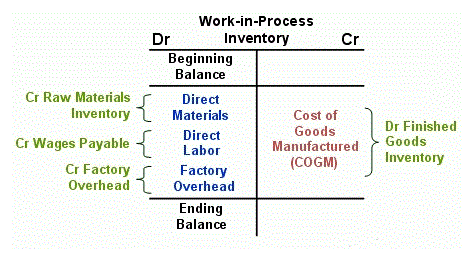Product Costing: What it is and why it matters

The software provides an array of tools that simplify product costs consist of the cost-tracking process and allow you to focus on what really matters — your business. This wasn’t meant to be a pun, but product costs are also accounted for in accounting. They are essentially categorized as inventory on the balance sheet and can be tracked in the inventory account (which is often referred to as a current asset). Standard costing uses predetermined standard costs for materials, labor, and overhead.
- By understanding the components that contribute to these costs, businesses can refine pricing strategies, optimize resource allocation, and enhance profitability.
- Therefore, businesses must always balance these two factors when pricing their products.
- Labor efficiency ratios, such as the labor productivity ratio, provide insights into labor resource utilization.
- Effective pricing strategies consider market conditions and competitor pricing.
- The goal is to create a more accurate picture of the actual cost of each product.
- Still, it is very difficult or insignificant to trace the low value of grease used in a particular vehicle hence referred to as indirect costs.
Three Ways to Reduce Indirect Costs
Business owners who do not have a clear understanding of their costs are more likely to underprice their products or services. This can lead to financial problems down the road, as the business may not be able to cover its costs and become profitable. Once you’ve arrived at an optimal budget for materials, add the labor cost to the total. This includes wages for employees or contracted workers involved in making the product. The tires that are bought or manufactured in the plant are necessary to produce a finished car. These costs are directly added to the total production cost of a finished good.
B. Direct Labor

After the total product cost is calculated, a markup is added to determine the selling price of the product. You can accurately determine your product’s cost by considering all three components. Knowing this information is essential for setting competitive prices and maximizing profits.

You may miss out on sales.
- It is essential to understand product cost to optimize direct materials usage.
- It can be costly to fully build out this level of complex software and maintain it.
- It can be helpful in decision-making by providing a more accurate picture of the actual cost of each product.
- This is because the cost of the fixed assets used to produce the product is included in the manufacturing overhead cost, which is then included in the total product cost.
- The total product costs you have incurred for any given period should be reported on the income statement only when sold.
By staying on top of their financials, businesses can ensure that their product costs are accurate and allow them to make informed decisions. The budget includes every cost related to the production process other than costs related to direct material and direct labor. The final costs determined as per the overhead budget are not capitalized under the balance sheet but expensed in the income statement as cost of goods sold. Direct product costs are the costs that can be traced directly to the production of a specific product, such as raw materials, direct labor, and direct overhead. Product and production costs are closely intertwined, making it essential for any business to understand this relationship to succeed in its market. It is essential to consider all elements in the production process when determining product cost, including labor, materials, overhead expenses, shipping fees, etc.
- It encompasses a wide range of costs, including research, design, development, testing, deployment, and ongoing support and maintenance.
- So, allocating any portion of that cost to each product produced would be inaccurate.
- To eliminate overhead costs, a manager may modify product cost when making short-term product and unit pricing decisions.
- Without a project plan or product roadmap, it’s hard to make sure all stakeholders and teams are on the same page.
- To prevent losses, the sales cost must be equivalent to or greater than the product cost per unit.
- These costs are not part of the manufacturing process and are, therefore, treated as expense for the period in which they arise.
- Period costs are expensed immediately, reflecting ongoing operational expenses, while product costs are capitalized and impact profitability over time.

Product costs are costs that are incurred to create a product that is intended for sale to customers. Product costs include direct material (DM), direct labor (DL), and manufacturing overhead (MOH). Product costs (also known Accounting for Marketing Agencies as inventoriable costs) are those costs that are incurred to acquire, manufacture or construct a product. In manufacturing companies, theses costs usually consist of direct materials, direct labor, and manufacturing overhead cost. The total product costs you have incurred for any given period should be reported on the income statement only when sold. This will give you an accurate view of your cost structure, and it’s also essential information when calculating taxes owed or other financial statements.
With careful planning and analysis, businesses can effectively manage product and production costs to maximize profitability. With these essential points in mind, businesses can gain valuable insights into their financial performance and bookkeeping optimize product cost accounting. Accurate records are vital for understanding how much it costs to produce a product or service and maximizing profits.
The Consequences Of Overcosting – Why It Can Be Harmful To A Business

Additionally, taking advantage of economies of scale can help reduce production costs. With careful research, accurate calculations, and proper consideration of all components, companies can calculate their product costs accurately. Because it comprises the production overhead required by GAAP and IFRS, product cost appears in the financial statements. To avoid these consequences, it is important for businesses to carefully consider their production cost assumptions and regularly review them to ensure that they are still accurate. They should also have contingency plans in place in case of unexpected cost increases. Indirect or fixed costs are not easily traced back to a specific cost center, product, or project.
In contrast, period costs are not directly connected to the production of a particular product and are expensed in the period in which they are incurred. In conclusion, while depreciation is not considered a direct product cost, it is an indirect cost that is included in the manufacturing overhead cost and the total product cost. However, it can be argued that depreciation is an indirect component of the cost of a product. This is because the cost of the fixed assets used to produce the product is included in the manufacturing overhead cost, which is then included in the total product cost. Before deciding, each business must weigh the risks and consequences of overcosting or undercosting its products or services.

